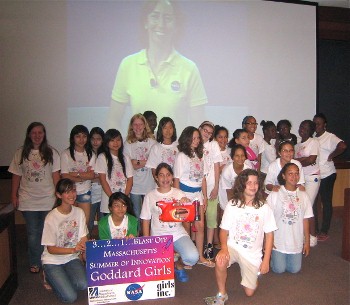Middle school “Goddard Girls” rocketed around campus in August as part of a weeklong science exploration camp
Ten, nine, eight… NASA, we have lift off!
 |
| The Goddard Girls participated in a live video conference with Liz Warren, PhD, an International Space Station medical operations scientist during a trip to UMMS. |
Earlier this year, NASA’s program provided a $1.5 million grant to just six sites in Massachusetts, including UMass Medical School, which was the only non-engineering/space institution to receive funding. The Goddard Girls program, named in recognition of Worcester native Robert Goddard, the father of modern rocketry, was developed by the UMMS Regional Science Resource Center (RSRC) and Girls, Inc., and provided two weeks of STEM-related activities for middle school girls throughout the region.
“In May, NASA administrator and former astronaut Charles Bowden met with Governor Deval Patrick to announce the grant winners,” said Sandy Mayrand, RSRC director. “I was so proud that our proposal was selected along with five other remarkable engineering and science programs. I think it was impressive for these girls to come to the Medical School and see biomedical research and health care in the context of space travel and NASA. I think it opened their eyes.” (To read a related story about the grant, click here.)
Numerous MASOI projects are being conducted this summer by a number of schools in partnership with the University of Massachusetts, Framingham State College, Worcester Polytechnic Institute, Tufts University and MIT. MASOI projects are required to have NASA content including robotics, earth and space science, astrophysics and engineering. The projects are also required to develop ways to keep students and teachers engaged during the school year, and to track participants’ performance through 2012.
Mayrand said that this summer, the Goddard Girls focused on “the world of space travel, its impact on the human body and how we use science, creativity and perseverance to solve its challenges.” The girls, in grades 5 through 9, toured the UMMS Simulation Center—which, according to their blog on the Girls, Inc. Web site, was “pretty cool”—and solved design challenges developed by NASA specifically for this program. Mayrand and RSRC Science Coordinator Karin Spahl also utilized NASA materials to help the girls build models of a crew exploration vehicle and design moon habitats. The girls visited the planetarium at Worcester’s EcoTarium, and, at MIT, explored the process of space suit design and experienced the Moon Walker.
A highlight of their trip to UMMS was a live video conference with Liz Warren, PhD, an International Space Station medical operations scientist at the Johnson Space Center in Houston, Texas. Dr. Warren taught the girls the difference between zero gravity and microgravity, and why astronauts—who can spend up to six months on the space station—experience physical changes such as decreases in bone density and blood volume, loss of muscle mass and a slight decrease in the size and strength of the heart while in space. She discussed NASA’s efforts to better understand and mitigate the long-term effects on astronauts’ health—and what these findings may mean for Earth-bound people—and described the somewhat quirky problems of exercising in space: “How can we jog or do pushups without gravity? We’d just float away!”
The girls asked insightful questions, including “How do you sleep in space?” (floating, Warren said, usually very comfortably though “sometimes it’s weird not to have a pillow”) and “How do you drink in space?” (with a straw that pinches closed to prevent spills or leaks). They also learned that drink pouches and food pouches are outfitted with Velcro tabs so they can be attached to space suits, and, although the astronauts do get to have M&Ms, most foods are soft and sticky because wayward crumbs could float into and damage sensitive equipment. The girls also asked about the education and training needed not just to become an astronaut—most agreed they might miss their families too much on a six-month tour of space—but also to become a NASA scientist or engineer, or an astronauts’ physician.
Raji R. Patel, MASOI director and MSCG co-director, was delighted to have UMMS involved in the program and to experience a group of students different from the graduate students she generally works with at MIT. “This was my first foray into any such program with middle schoolers,” she said, adding that she found the young students refreshing and the RSRC impressive. “The basic human curiosity that is so important in science is wonderfully evident in these girls and I’ve been thrilled to work with UMass to help foster their enthusiasm and excitement about STEM experiences.”
At the end of the summer, NASA will evaluate the Summer of Innovation program with an eye toward implementing a comprehensive program for 2011 and beyond.